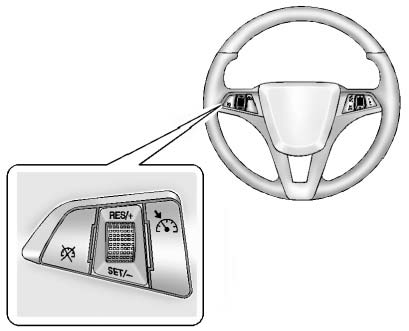Chevrolet Cruze Owners Manual: Cruise Control
For vehicles with cruise control, the vehicle can maintain a speed of about 40 km/h (25 mph) or more without keeping your foot on the accelerator. Cruise control does not work at speeds below 40 km/h (25 mph).
If the brakes are applied, the cruise control shuts off.
The vehicle has a Traction Control System (TCS) or StabiliTrak system that begins to limit wheel spin while using cruise control and the cruise control will automatically disengage. When road conditions allow you to safely use it again, the cruise control can be turned on.
WARNING
Cruise control can be dangerous where you cannot drive safely at a steady speed. So, do not use the cruise control on winding roads or in heavy traffic.
Cruise control can be dangerous on slippery roads. On such roads, fast changes in tire traction can cause excessive wheel slip, and you could lose control. Do not use cruise control on slippery roads.

 (On/Off)
(On/Off)
: Press to turn the cruise control system on and off.
RES/+ (Resume/Accelerate):
Move the thumbwheel up to resume a previously set speed or to accelerate.
SET/− (Set/Coast)
: Move the thumbwheel down to set a speed or to make the vehicle decelerate.
 (Cancel):
(Cancel):
Press to disengage cruise control without erasing the set speed from memory.
Setting Cruise Control
If the cruise button is on when not in use, it could get bumped and go into cruise when not desired. Keep the cruise control switch off when cruise is not being used.
1. Press 
.
2. Get to the speed desired.
3. Move the thumbwheel down and release it.
4. Take your foot off the accelerator pedal.
Resuming a Set Speed
If the cruise control is set at a desired speed and then the brakes or clutch for manual transmissions are applied, the cruise control is disengaged without erasing the set speed from memory.
Once the vehicle reaches about 40 km/h (25 mph) or more, move the thumbwheel up toward RES/+ briefly. The vehicle returns to the speed selected previously and stays there.
Increasing Speed While Using Cruise Control
If the cruise control system is already activated: • Move the thumbwheel up toward RES/+ and hold it until the desired speed is reached, then release it.
• To increase the speed in small amounts, move the thumbwheel up toward RES/+ briefly and then release it. Each time this is done, the vehicle goes about 1.6 km/h (1 mph) faster.
Reducing Speed While Using Cruise Control
If the cruise control system is already activated: • Move the thumbwheel toward SET/− and hold until the desired lower speed is reached, then release it.
• To slow down in small amounts, move the thumbwheel toward SET/− briefly. Each time this is done, the vehicle goes about 1.6 km/h (1 mph) slower.
Passing Another Vehicle While Using Cruise Control
Use the accelerator pedal to increase the vehicle speed. When you take your foot off the pedal, the vehicle slows down to the previous set cruise control speed.
Using Cruise Control on Hills
How well the cruise control works on hills depends upon the vehicle speed, load, and the steepness of the hills. When going up steep hills, you might have to step on the accelerator pedal to maintain the vehicle speed. When going downhill, you might have to brake or shift to a lower gear to maintain the vehicle speed. When the brakes are applied, the cruise control is disengaged.
Ending Cruise Control
There are three ways to end cruise control: • To disengage cruise control, step lightly on the brake pedal or clutch for a manual transmission.
• Press  on the steering wheel.
on the steering wheel.
• To turn off cruise control, press  on
the steering wheel.
on
the steering wheel.
Erasing Speed Memory
The cruise control set speed is erased from memory if 1 is pressed or if the ignition is turned off.
is pressed or if the ignition is turned off.
 StabiliTrak® System
StabiliTrak® System
The vehicle has a vehicle stability enhancement system called StabiliTrak. It
is an advanced computer controlled system that assists with directional control
of the vehicle in difficult driving co ...
Other materials:
Tire Pressure Light
For vehicles with the Tire Pressure Monitor System (TPMS), this light comes on
briefly when the engine is started. It provides information about tire pressures
and the TPMS.
When the Light Is On Steady
This indicates that one or more of the tires are significantly underinflated.
A Driver In ...
Work Stall Test Warning
Warning: One or more of the following guidelines may apply when performing
specific required tests in the work stall:
When a test requires spinning the drive wheels with the vehicle jacked up,
adhere to the following precautions:
Do not exceed 56 km/h (35 mph) when spinning one drive wheel ...
Power Door Latch Description and Operation
Power Door Latch System Components
The power door latch system consists of the following components:
Remote control door lock receiver
Body control module (BCM)
Driver door latch
Passenger door latch
Left rear door latch
Right rear door latch
Door handle assemblies
Power Door Lat ...

